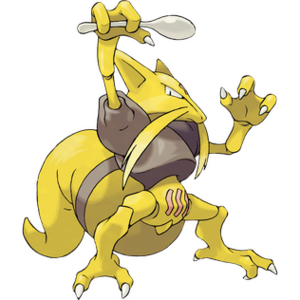Kadabra facts for kids
Quick facts for kids Kadabra |
|
|---|---|
| Pokémon series character | |

|
|
| First game | Pokémon Red and Blue (1996) |
| Designed by | Ken Sugimori |
| Voiced by | |
| Information | |
| Species | Pokémon |
| Type | Psychic |
Kadabra, known as Yungerer in Japan, is a Pokémon species. It is part of the popular Pokémon games and shows. Kadabra is the middle stage of a Pokémon family. It evolves from Abra and then evolves into Alakazam.
Kadabra is mostly yellow and looks like a human. It has two long, pointed ears on its head. A red star marks its forehead. It also has narrow eyes and a thin snout. Ken Sugimori created Kadabra. It first appeared in the video games Pokémon Red and Blue in 1996. Since then, Kadabra has been in many Pokémon games. It also appears in merchandise, spin-off games, and the Pokémon TV show.
In the Pokémon TV show, a character named Sabrina owns a Kadabra. Kadabra also appears in the Pokémon Adventures comic books. Some critics have shared mixed opinions about Kadabra.
Contents
About Kadabra's Design
Kadabra was designed by the Game Freak team. Ken Sugimori finalized its look for the first Pokémon games. These games were Red and Green in Japan. They later became Pokémon Red and Blue outside Japan.
Its Japanese name is Yungerer. Nintendo changed the name for English-speaking audiences. This made the Pokémon more familiar to new players. Kadabra's name comes from the magic word "Abracadabra." Its earlier form, Abra, and its final form, Alakazam, also follow this theme.
Kadabra stands on two legs and looks a bit like a fox. It has parts that look like armor on its shoulders. It also has a piece around its chest that looks like a skirt of armor. Kadabra has three fingers on each hand and three toes on each foot. It also has a thick tail. Male Kadabra have a larger mustache than females.
A red star shape is on its forehead. Three red wavy lines are on its chest. These lines look like symbols used on zener cards, which are used in psychic tests. Kadabra, like its related Pokémon, can use telepathy. This means it can read or send thoughts. It can also control others' minds and teleport from one place to another.
Kadabra in Games and Shows
Kadabra first appeared in the Pokémon Red and Blue video games. Abra evolves into Kadabra after gaining enough experience. Kadabra then evolves into Alakazam when it is traded between two Pokémon games.
Kadabra has been in every main Pokémon game since its first appearance. This includes new versions of Red and Blue and all later sequels.
Kadabra in the TV Show and Comics
In the Pokémon TV show, the Saffron City Gym Leader, Sabrina, owns an Abra. During a battle with Ash, Sabrina's Abra evolves into Kadabra. Kadabra's new psychic powers make Ash give up the match.
Ash later returns for a rematch. Ash's Haunter makes Sabrina laugh. Because Kadabra and Sabrina share a psychic bond, Kadabra also starts to laugh. Since they are both laughing, they cannot fight. Sabrina then gives Ash the gym badge.
A Kadabra also appeared in an episode called "Fear Factor Phony." In this episode, it was in an abandoned mining area with other Psychic-type Pokémon. This was Kadabra's last physical appearance in the TV show for a while. However, its earlier form Abra and its evolution Alakazam still appear.
Just like in the TV show, Sabrina owns a Kadabra in the Pokémon Adventures comic books.
Kadabra's Impact and Lawsuit
The Uri Geller Lawsuit
In 2000, a famous Israeli "psychic" and magician named Uri Geller sued Nintendo. Geller claimed he could bend spoons with his mind. He sued because Kadabra's Japanese name, Yungera, sounded like his name. He felt Nintendo used his identity without permission.
Geller learned about this when fans showed him Kadabra cards. They noticed the similarity between him and the Pokémon. He also claimed the star on Kadabra's forehead and the lightning patterns on its body were bad symbols. He felt Nintendo had turned him into an "evil" character.
Nintendo said there was no connection between Kadabra and Geller. They stated they did not name Pokémon after real people. In 2008, a director for the Pokémon TV show confirmed something important. He said Kadabra would not appear on Pokémon Trading Cards until the lawsuit was settled.
In November 2020, Uri Geller changed his mind. He had received many emails from Pokémon fans asking him to drop the case. Geller then announced he gave Nintendo permission to print Pokémon cards with Kadabra again.
See also
 In Spanish: Kadabra para niños
In Spanish: Kadabra para niños

